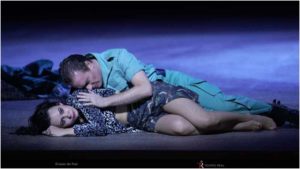
Teatro Real De Madrid 2017-18 Review – Carmen: Calixto Bieito’s Vision Gains Relevancy in Spain’s Current Tumultuous Times
By Santosh VenkataramanThis marked my third time traveling to Madrid. What made this one unique was the number of Spanish flags in neighborhoods in the capital – a result of recent events in which autonomous Catalonia is seeking independence.
That political backdrop brought further relevance to Calixto Bieito’s production of “Carmen,” seen at the beautiful Teatro Real on Thursday night. It’s a production that was first performed in 1999 in the Catalonia region, and it’s one that has created controversy in opera – like the provocateur Bieito himself.
I was supposed to see this production last summer in San Francisco, where the work of Bieito was presented for the first time to an audience in the United States. Alas, those plans fell through. And before I get to my thoughts on this presentation, I would be remiss first not to say that on this night this Spanish crowd absolutely loved it with a thoroughly roaring ovation.
Bieito Setting in Africa
Bieito has said that his production could be set in any border area; this one is placed in autonomous Ceuta, part of Spain adjacent to Morocco off the Mediterranean coast. Its time is the latter part of the 1970s after Franco’s reign gave way to Spanish democracy; this is vastly different from a “Carmen” set in the early 19th century in Seville.
The Spanish flag flies high in the first scene in Africa. Nearby are Spanish soldiers administeringthe border in addition to crooks, peddlers and other shady characters present in a tourist-heavy region.
Carmen?
Maybe the best way to view this production is not to look at it as “Carmen” at all. In fact, the director has stated that it is necessary to present classic works in conditions that resemble modern times to engage with modern audiences. I do agree with that sentiment.
Here’s an example from Bieito’s “Carmen.” The letter scene in which Micaëla brings Don Jose a note from his mother, is one of the most touching parts of the opera, featuring a duet that is simply sublime. Viewed in comparison, this production not only cuts part of the music in that scene but also has Micaëla taking odd photos during it. An observer could say that someone has hacked Bizet’s “Carmen” apart.
However, if you read the director’s intentions, it’s as if he is trying to minimize the presence of Micaëla, sung by soprano Eleonora Buratto, clad in a garish green and purple top and clutching a blue purse. This scene comes off totally different with that viewpoint.
Sexually Excessive? Maybe Not So Much
Bieito’s reputation is that of hypersexualization, although this “Carmen” wasn’t over the top in this regard. There is a naked man present in the opening of Act three, although the lighting is too dim to see everything. The cigarette girls are dressed provocatively but it’s more indicative of the seediness of the setting than about their sexuality.
There are other visual elements that this staging will be remembered for. They are the phonebooth in which much of Act 1 centers around and in which Carmen sings part of her habanera. Another is the huge bull in the backdrop during Act three that crashes to the ground with a thud.
The director’s vision probably overwhelms other aspects of the performance, most notably the music and the singing. Conductor Marc Piollet and the work of the Teatro Real were not memorable, whether it was due to the musical cuts required or other factors.
One exception was the chorus, which was a highlight throughout the night, especially visually.
Gamely Cast
It was hard to remember that a first-rate cast was on stage. Buratto is a singer on the upswing who is terrific to listen to. I heard her Micaëla last season in Chicago; there, her character was more of a focal point as someone trying to rescue Don Jose than in this version.
Tenor Francesco Meli wore a series of costumes that made his Don Jose odd-looking. Yet that kept in line with the expectations of this production. His Flower Aria, “La fleur que tu m’avais jeté,” was powerful and emotive, although it was hard to take his character seriously wearing jeans and a brown leather jacket.
Veteran bass-baritone Kyle Ketelsen wears a suit through most of his Escamillo, although he was finally clad in bullfighting gear in his duet with Carmen in the final act. Ketelsen was smooth vocally and brought a certain level of arrogance to his portrayal of the toreador.
The performer who probably had the best night was mezzo-soprano Anna Goryachova in the title role. She had a commanding presence for a petite woman, representing female empowerment more so than a whimsical gypsy woman.
Making Carmen Relevant
I would not recommend this to diehard lovers of Carmen and Bizet’s music. However, Bieito’s vision really is more about something else than the story of Carmen. This is especially relevant given current events in Spain, and what it means to have autonomy and yet be under the rule of someone else. It would be wrong to disagree with a packed house of Spaniards that came for a spectacle and continue to adore this production. If you ever see it, try to see it through their eyes rather than your own.


